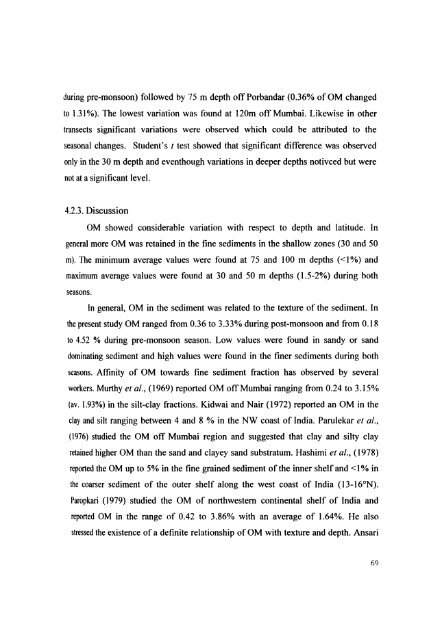L - Cochin University of Science and Technology
L - Cochin University of Science and Technology
L - Cochin University of Science and Technology
Create successful ePaper yourself
Turn your PDF publications into a flip-book with our unique Google optimized e-Paper software.
during pre-monsoon) followed by 75 m depth <strong>of</strong>f Porb<strong>and</strong>ar (0.36% <strong>of</strong> OM changed<br />
to 1.31 %). The lowest variation was found at 120m <strong>of</strong>f Mumbai. Likewise in other<br />
transects significant variation:; were observed which could be attributed to the<br />
seasonal changes. Student's t test showed that significant difference was observed<br />
only in the 30 m depth <strong>and</strong> eventhough variations in deeper depths notivced but were<br />
not at a significant level.<br />
4.2.3. Discussion<br />
OM showed considerable variation with respect to depth <strong>and</strong> latitude. In<br />
general more OM was retained in the fine sediments in the shallow zones (30 <strong>and</strong> 50<br />
m). The minimum average values were found at 75 <strong>and</strong> 100 m depths «I %) <strong>and</strong><br />
maximum average values were found at 30 <strong>and</strong> 50 m depths (1.5-2%) during both<br />
seasons.<br />
In general, OM in the sediment was related to the texture <strong>of</strong> the sediment. In<br />
the present study OM ranged from 0.36 to 3.33% during post-monsoon <strong>and</strong> from 0.18<br />
to 4.52 % during pre-monsoon season. Low values were found in s<strong>and</strong>y or s<strong>and</strong><br />
dominating sediment <strong>and</strong> high values were found in the finer sediments during both<br />
seasons. Affinity <strong>of</strong> OM towards fine sediment fraction has observed by several<br />
workers. Murthy et al., (1969) reported OM <strong>of</strong>f Mumbai ranging from 0.24 to 3.15%<br />
(av. 1.93%) in the silt-clay fractions. Kidwai <strong>and</strong> Nair (1972) reported an OM in the<br />
clay <strong>and</strong> silt ranging between 4 <strong>and</strong> 8 % in the NW coast <strong>of</strong> India. Parulekar et al.,<br />
(1976) studied the OM <strong>of</strong>f Mumbai region <strong>and</strong> suggested that clay <strong>and</strong> silty clay<br />
retained higher OM than the s<strong>and</strong> <strong>and</strong> clayey s<strong>and</strong> substratum. Hashimi et al., (1978)<br />
reported the OM up to 5% in the fine grained sediment <strong>of</strong> the inner shelf <strong>and</strong>

















